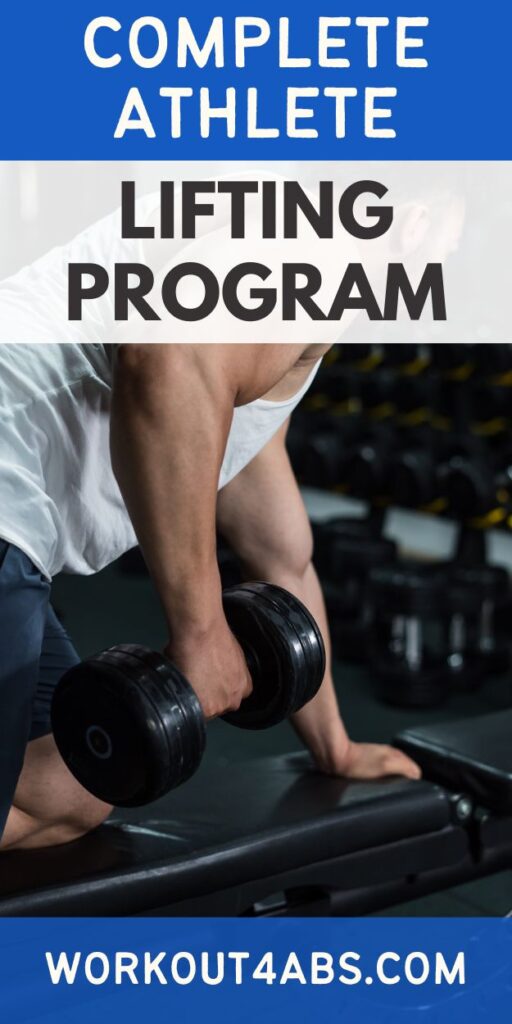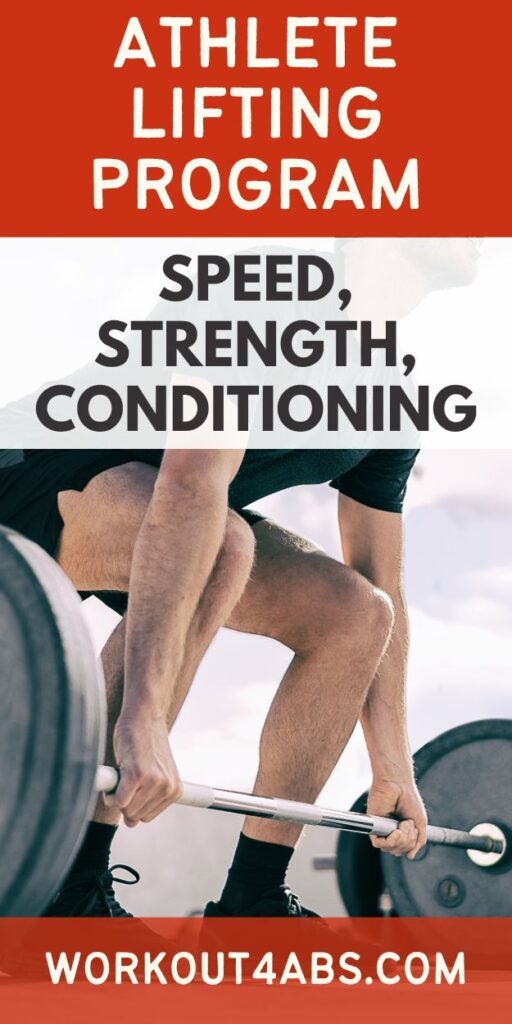You’re about to explore an athlete lifting program. This is a comprehensive month-long lifting program designed specifically for athletes, emphasizing performance-oriented training. We also explore the distinctive differences between athlete-focused training and bodybuilding, shedding light on their unique goals and methodologies.
Lifting Program for an Athlete vs Lifting Program for a Bodybuilder
Lifting programs for athletes and bodybuilders differ significantly in their goals, training methodologies, and priorities. These differences are primarily driven by the distinct objectives each group aims to achieve:
Lifting Program for an Athlete:
- Performance-Oriented: The primary goal of an athlete’s lifting program is to enhance athletic performance in their specific sport. This includes improving speed, power, agility, endurance, and sport-specific skills.
- Functional Strength: Athletes focus on developing functional strength that directly translates to their sport. Exercises are selected based on their relevance to sport-specific movements and requirements.
- Periodization: Athletes often use periodization, a systematic approach to training that divides the year into distinct training phases. These phases typically include an off-season, pre-season, in-season, and post-season, with different emphasis on strength, conditioning, and skill development during each phase.
- Varied Reps and Sets: Training includes a wide range of rep and set schemes, depending on the phase of training. This may involve low-rep, high-weight strength work, as well as higher-rep, lower-weight conditioning and skill-specific drills.
- Sport-Specific Drills: Athletes incorporate sport-specific drills and exercises that mimic the movements and demands of their sport. This can include agility drills, plyometrics, and sport-specific movements with resistance.
- Cardiovascular Conditioning: Cardiovascular conditioning is a crucial component of an athlete’s program to improve endurance and recovery during competition.
- Nutrition and Recovery: Nutrition, rest, and recovery are closely monitored to ensure peak performance. Athletes often work with sports nutritionists and recovery specialists.
Lifting Program for a Bodybuilder:
- Aesthetics-Oriented: Bodybuilders focus primarily on achieving a well-defined and aesthetically pleasing physique with an emphasis on muscle size, symmetry, and definition.
- Hypertrophy Training: Bodybuilders primarily engage in hypertrophy training, which involves higher-rep, moderate-weight sets to maximize muscle growth. The goal is to create muscle hypertrophy for a visually appealing physique.
- Isolation Exercises: Bodybuilders often include a wide variety of isolation exercises that target specific muscle groups. These exercises help develop individual muscle groups to create a balanced and sculpted appearance.
- Nutrition and Dieting: Nutrition plays a central role in bodybuilding. Bodybuilders follow strict dietary regimens to control body fat percentage and optimize muscle growth. This may involve bulking and cutting phases.
- Competition Focus: Bodybuilders often compete in bodybuilding competitions to showcase their physique. Preparation for these events involves specific training and dieting cycles leading up to the competition.
- Less Emphasis on Cardio: While cardiovascular health is not ignored, it is typically of secondary importance to muscle development for bodybuilders. Cardio is used more for calorie management and conditioning.
- Less Sport-Specific: Bodybuilding is not tied to a specific sport, so the focus is on overall muscular development rather than sport-specific skills or movements.
In summary, the key difference between a lifting program for an athlete and a bodybuilder lies in their primary goals. Athletes aim to improve sport-specific performance, while bodybuilders focus on achieving a specific aesthetic and maximizing muscle size and definition. These differences result in variations in training methodologies, exercise selection, rep and set schemes, and nutritional strategies.
Complete Lifting Program for an Athlete
Creating a month-long lifting program for an athlete requires careful planning and consideration of the athlete’s specific sport, goals, and current fitness level. Here’s a sample program that factors in the mentioned variables:
Week 1: General Strength and Conditioning (Off-Season)
Day 1: Strength and Power
- Back Squats – 4 sets of 5 reps (heavy)
- Power Cleans – 4 sets of 3 reps (explosive)
- Medicine Ball Throws – 3 sets of 8 reps (power)
Day 2: Sport-Specific Drills
- Sport-Specific Agility Drills – 20 minutes
- Cone Drills – 3 sets of 6 reps (agility)
Day 3: Cardiovascular Conditioning
- Long-Distance Run – 30-45 minutes (steady-state)
- Core Strengthening Exercises – 3 sets
Day 4: Active Recovery
- Light Jog or Swim – 20-30 minutes
- Yoga or Mobility Work – 30 minutes
Day 5: Strength Endurance
- Split Squats – 3 sets of 10 reps (each leg)
- Push-Ups – 3 sets of 15 reps
- Planks – 3 sets of 30 seconds
Week 2: Hypertrophy and Sport-Specific Skills (Off-Season)
Day 1: Hypertrophy and Power
- Front Squats – 4 sets of 8 reps (moderate weight)
- Box Jumps – 4 sets of 5 reps (explosive)
- Medicine Ball Slams – 3 sets of 10 reps (power)
Day 2: Sport-Specific Skills
- Sport-Specific Drills – 30 minutes (intense)
- Sport-Specific Conditioning Drills – 20 minutes
Day 3: Cardiovascular Conditioning
- Interval Sprints – 8 x 100 meters with 1-minute rest
- Core Strengthening Exercises – 3 sets
Day 4: Active Recovery
- Light Bike Ride or Swim – 30 minutes
- Foam Rolling – 20 minutes
Day 5: Strength Endurance and Core
- Bulgarian Split Squats – 3 sets of 12 reps (each leg)
- Push-Ups with Claps – 3 sets of 12 reps
- Russian Twists – 3 sets of 15 reps (each side)
Week 3: Power and Skill Development (Pre-Season)
Day 1: Power and Strength
- Deadlifts – 4 sets of 5 reps (heavy)
- Hang Clean and Jerk – 4 sets of 3 reps (explosive)
- Box Jumps – 3 sets of 6 reps (power)
Day 2: Sport-Specific Skills
- Sport-Specific Drills – 40 minutes (intense)
- Sport-Specific Conditioning Drills – 30 minutes
Day 3: Cardiovascular Conditioning
- Hill Sprints – 6 x 150 meters with 2-minute rest
- Core Strengthening Exercises – 3 sets
Day 4: Active Recovery and Mobility
- Light Yoga or Mobility Work – 30 minutes
- Foam Rolling – 20 minutes
Day 5: Strength Endurance and Core
- Step-Ups with Dumbbells – 3 sets of 15 reps (each leg)
- Push-Ups with Resistance Bands – 3 sets of 15 reps
- Planks with Arm/Leg Raises – 3 sets of 45 seconds
Week 4: Peak Performance (In-Season)
Day 1: Maintenance and Skill Refinement
- Squats – 3 sets of 5 reps (moderate weight)
- Sport-Specific Skill Drills – 30 minutes
Day 2: Sport-Specific Skills and Conditioning
- Sport-Specific Drills – 40 minutes (game-like intensity)
- Sport-Specific Conditioning Drills – 40 minutes
Day 3: Active Recovery and Mobility
- Light Bike Ride or Swim – 30 minutes
- Yoga or Mobility Work – 30 minutes
Day 4: Game Day
Day 5: Active Recovery and Nutrition Focus
If you enjoyed these tips, please save this pin to your Pinterest Board.
- Light jog or swim – 20-30 minutes
- Nutrition and Recovery Strategies – Focus on hydration, protein, and quality sleep.
Please note that this program is a general example and should be customized based on the athlete’s sport, individual needs, and consultation with a coach or fitness professional. Also, proper warm-up and cool-down routines, as well as stretching, should be included in each training session to reduce the risk of injury. Nutrition and recovery strategies should be tailored to the athlete’s specific goals and dietary requirements.

How To Build Your Hybrid Athlete Program (Running + Lifting)
Set a Personal Goal
Identifying the goal is indeed the crucial first step in developing a strength and conditioning program. This initial step serves as the foundation upon which the entire program is built, and it’s essential for several reasons:
- Clarity and Focus: Identifying the goal provides clarity and focus to the training program. Without a clear objective, it’s challenging to design a program that addresses specific needs or targets particular outcomes. When you know what you want to achieve, you can tailor your program accordingly.
- Efficiency: Knowing the goal allows for the efficient allocation of resources and effort. A well-defined goal helps determine the exercises, sets, repetitions, intensity, and duration required to reach that goal. This efficiency ensures that you’re not wasting time or energy on exercises or activities that don’t contribute to your desired outcome.
- Motivation: Setting a specific goal can be highly motivating. It gives you something to work towards, and the sense of accomplishment when you achieve that goal can be a powerful driving force. Whether the goal is to build muscle, increase endurance, improve athletic performance, or enhance overall health, having a clear objective can keep you motivated and committed to your training program.
- Measurement and Progress Tracking: Goals provide a benchmark for measuring progress. By establishing concrete goals, you can track your performance and determine whether your training program is effective. Regularly assessing your progress allows you to make adjustments as needed to stay on course.
- Customization: Different goals require different approaches. For example, a program designed to build strength will differ from one focused on improving cardiovascular fitness or flexibility. By identifying the goal, you can tailor your program to address the specific needs and requirements associated with that goal, ensuring it’s as effective as possible.
- Risk Reduction: Training without a clear goal can lead to overtraining or injury. By setting a goal and designing a program around it, you can establish safe and gradual progressions, minimizing the risk of overuse injuries or burnout.
- Long-term Sustainability: Knowing the purpose behind your training helps you see the bigger picture. It encourages you to develop a sustainable and balanced approach to fitness that aligns with your goals and overall well-being.
In summary, identifying the goal is essential in strength and conditioning programs because it provides direction, motivation, and a framework for effective training. Without a clear goal, your efforts may lack direction, and you might not achieve the results you desire. By setting and chasing a specific goal, you maximize the chances of success and ensure that your training program is purposeful and efficient.
If you enjoyed these tips, please save this pin to your Pinterest Board.

Training Frequency
Identifying a training frequency is a critical component of any well-structured fitness program, as it helps ensure that you achieve your health and fitness goals effectively and safely. In the context of cardiovascular conditioning and strength training, let’s explore the importance of having a specific training frequency:
- Consistency: Establishing a training frequency, such as three strength training sessions and three cardio sessions per week, promotes consistency in your workout routine. Consistency is key to making progress in both cardiovascular fitness and strength gains. Regular workouts help your body adapt to the demands of exercise, leading to improved performance and health benefits.
- Balanced Approach: Combining both cardiovascular conditioning and strength training in your weekly routine is crucial for achieving a balanced approach to fitness. Cardiovascular exercise enhances heart and lung health, while strength training builds muscle, bone density, and functional strength. This balance is essential for overall health and longevity.
- Optimal Progress: The chosen frequency of three sessions per week for each type of training strikes a balance between providing enough stimulus to promote progress and allowing adequate time for recovery. Overtraining can lead to fatigue, injury, and decreased performance, so having a structured frequency ensures you’re pushing yourself enough without overexertion.
- Efficient Use of Time: With a set training frequency, you can plan your workouts more efficiently. Knowing when you’ll do cardio and strength training allows you to schedule your workouts around your other commitments and responsibilities. This increases the likelihood that you’ll stick to your routine, as it becomes a predictable and manageable part of your weekly schedule.
- Targeted Goals: Different fitness goals may require varying training frequencies. By identifying your specific goals, you can adjust the frequency as needed. For example, if your primary goal is to build strength, you might emphasize strength training sessions while reducing the number of cardio sessions, and vice versa if your focus is on cardiovascular health.
- Avoiding Plateaus: A consistent training frequency helps prevent plateaus in your fitness progress. When your body adapts to a specific routine, progress may slow down. By strategically adjusting your training frequency or intensity, you can continue to challenge your body and make gains over time.
- Injury Prevention: Adequate rest and recovery are crucial for preventing injuries, especially in strength training. Having a set training frequency ensures that you allow your muscles and joints to recover between sessions, reducing the risk of overuse injuries.
In summary, identifying a training frequency, such as the recommended three strength training sessions and three cardio sessions per week, is essential for achieving a well-rounded fitness routine that promotes health span and life span. It ensures consistency, balance, efficient use of time, and targeted progress toward your fitness goals. Ultimately, the right training frequency can help you maintain a healthy and active lifestyle throughout your life.
Progressive Overload
Progressive overload is a fundamental principle in strength training and muscle building. It’s the concept of gradually increasing the demands placed on your muscles over time, which is essential for getting bigger, faster, and stronger. Here’s how progressive overload works and why factors like exercise selection, style, reps, sets, weight, and rest periods are crucial in achieving and sustaining your fitness goals:
- Exercise Selection: The exercises you choose should target the specific muscles or muscle groups you want to develop. Proper exercise selection ensures that you’re effectively stimulating the muscles you intend to work on, contributing to growth and strength gains in those areas.
- Exercise Style: The way you perform an exercise, including your form and technique, impacts its effectiveness. Proper form not only maximizes muscle engagement but also reduces the risk of injury. Good form allows you to lift heavier weights safely, leading to progressive overload.
- Reps (Repetitions) and Sets: Repetitions refer to the number of times you perform a specific exercise, and sets are groups of repetitions. The number of reps and sets you do can influence the type of adaptation your muscles experience. For example, lower reps with heavier weights are often used for strength gains, while higher reps with lighter weights can be effective for muscle endurance and hypertrophy (size).
- Weight: The resistance or weight you use in your exercises is a crucial factor in progressive overload. As your muscles adapt and become stronger, you need to increase the resistance to continue challenging them. Gradually increasing the weight you lift ensures that you’re providing the stimulus for muscle growth and strength improvement.
- Rest Periods: The amount of rest between sets and exercises is important. Shorter rest periods can increase the intensity of your workout and may be beneficial for endurance and hypertrophy. Longer rest periods allow for recovery and are often necessary when lifting heavy weights for strength gains.
- Tracking and Documentation: Keeping records of your workouts is vital for implementing progressive overload effectively. Documenting the weight lifted, reps, sets, rest periods, and exercise variations helps you track your progress over time. It allows you to see where you’ve made improvements and where adjustments may be needed.
Why Progressive Overload Is Important:
- Stimulates Muscle Growth: Progressive overload is the primary driver of muscle hypertrophy. By consistently increasing the demands on your muscles, you encourage them to adapt and grow in size.
- Strength Gains: To get stronger, you must continually challenge your muscles with heavier weights. Progressive overload ensures that your muscles are exposed to increasing resistance, leading to increased strength over time.
- Prevents Plateaus: Without progressive overload, your body can adapt to a particular exercise routine, leading to plateaus in performance and muscle growth. Continually increasing the demands prevents these plateaus and promotes ongoing improvement.
- Injury Prevention: Gradual increases in resistance and proper form reduce the risk of overuse injuries that can occur when you attempt to lift too heavy too soon.
In summary, progressive overload is the cornerstone of getting bigger, faster, and stronger in strength training and muscle building. To implement it effectively, you must consider factors like exercise selection, style, reps, sets, weight, and rest periods while documenting your progress. This approach ensures that you consistently challenge your muscles, leading to continuous improvement and long-term fitness gains.
If you enjoyed these tips on core exercises for athletes and would like to keep it close to you at any time, just save this pin to your Pinterest Board.

Home › Workout for Athletes ›Athlete Lifting Program